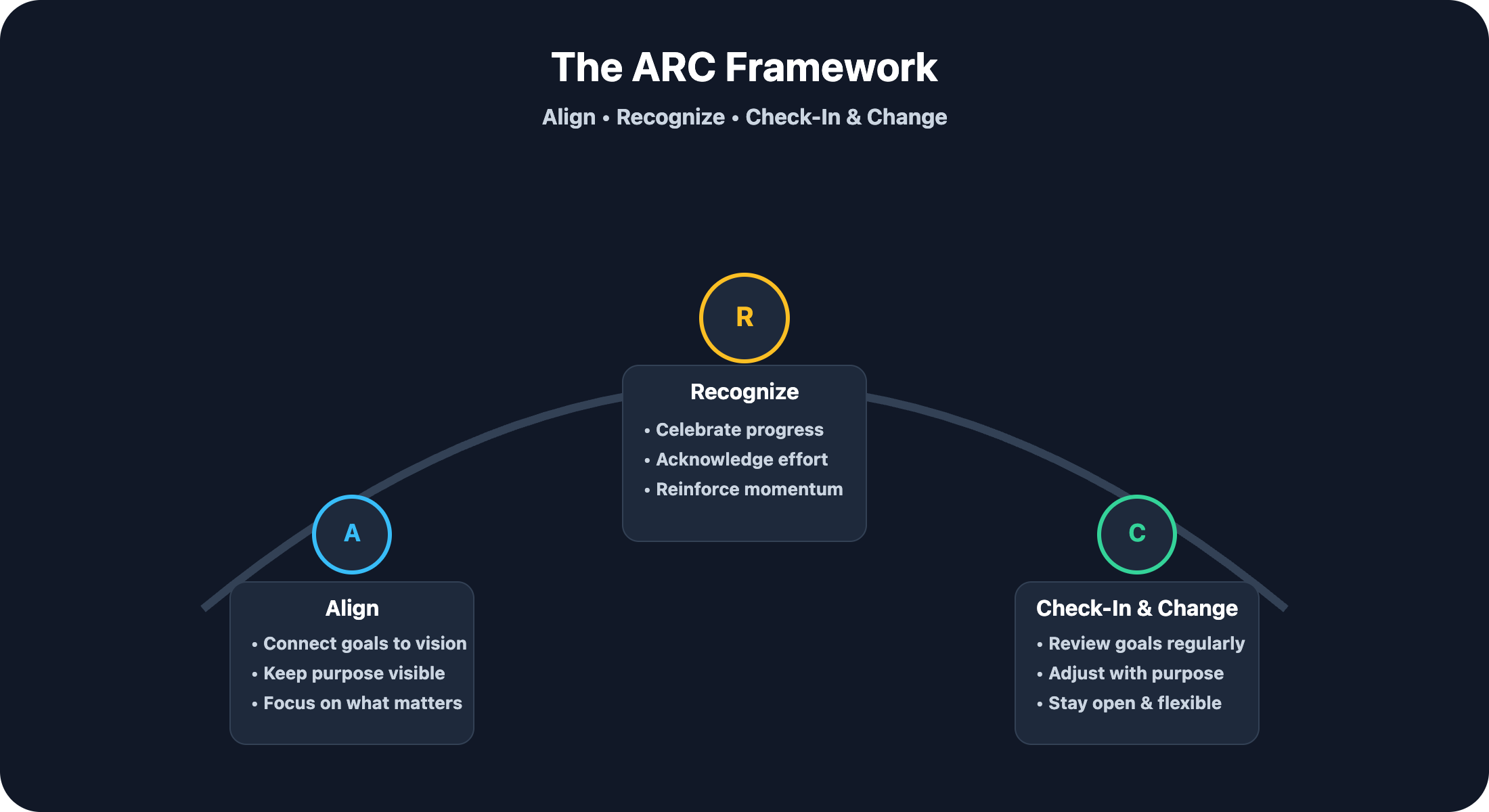A compelling vision is only as powerful as your ability to keep it present and relevant long after the initial excitement fades. Keeping the vision alive means weaving it into the fabric of your group’s routines, conversations, and celebrations. It’s about making the vision visible and tangible, so it doesn’t get lost in the noise of everyday life.
One practical way to do this is to use the ARC framework:

Keeping a shared vision or goal alive in any group can naturally incorporate all aspects of the ARC framework—revisiting shared goals regularly, recognizing progress and contributions, and checking in to adapt plans as needed. This continual reinforcement turns the vision into a shared touchstone that guides choices and sustains momentum over time.
Shared goals are the practical expression of your vision. They translate big-picture purpose into actionable steps. But even the best goals can lose relevance if they’re set once and never revisited. Regularly returning to your shared goals ensures they remain top-of-mind, aligned with evolving circumstances, and meaningful to everyone involved.
Build in regular moments to check in on progress toward shared goals. This could be as simple as starting a group meeting or study session with a quick review of how current activities connect to the vision, or as informal as chatting with friends about how things are going. Use these check-ins to ask questions like, “How does what we’re doing move us closer to our vision?” or “Are there new challenges or opportunities that mean we should adjust our approach?” These conversations help you align your efforts with your vision and keep everyone engaged. When you revisit goals, invite input from everyone involved. Encourage people to share what’s working, where they see gaps, and how the goals might need to evolve.
Nothing sustains momentum like visible progress. Publicly celebrating milestones—big or small—reinforces the value of the vision and energizes everyone to keep moving forward. Recognition transforms abstract aspirations into concrete achievements, making the vision feel real and attainable.
Make it a habit to highlight progress in group meetings, online chats, or informal gatherings. Be specific about what’s been accomplished and how it connects to the larger vision: “Thanks to everyone’s effort, we’ve reached our first major milestone! This brings us one step closer to our goal of making a real impact on campus.” When possible, tie individual and group contributions directly to the vision, showing how each person’s efforts matter. This is the recognize part of the ARC framework—celebrating progress and acknowledging contributions to keep motivation high.
Celebrating progress isn’t just about recognition, it’s also about learning. Use these moments to reflect on what enabled success, what challenges were overcome, and how the group can build on this momentum. This public acknowledgment creates a culture of appreciation and continuous improvement, making the vision a source of pride and motivation.
No plan survives unchanged in a dynamic environment. The ability to adapt while staying true to your core purpose is what separates resilient groups from those that lose their way. When circumstances shift, revisit your plans with the group, openly discussing what needs to change and why—while reaffirming the underlying vision that remains constant.
Frame adjustments as part of the journey, not as a sign of failure or indecision. This approach models flexibility and focus, showing that while tactics may shift, the purpose stays constant. Invite the group to help shape these adjustments. This collaborative problem-solving not only leads to better solutions but also reinforces everyone’s connection to the vision, even as the path evolves. This is the check-in & change part of the ARC framework—regularly reviewing and adapting your plans while keeping your purpose steady.
Here’s an example of how a group might naturally weave all parts of the ARC framework into their ongoing conversations. Imagine Jake, Natalie, and Ryan are part of a student organization working on a campus sustainability initiative. They’re meeting to discuss their progress and next steps:
- Jake: We set out to reduce single-use plastics at campus events, but lately I’m not sure if our activities are really making a difference. Are we still on track with our original vision?
- Natalie: That’s a good point. Our vision was to make campus events more sustainable overall, not just focus on plastics. Maybe we should start each meeting by quickly checking how our current projects—like the reusable cup program—fit into that bigger goal.
- Ryan: I agree. And honestly, we should give ourselves some credit. The reusable cup program at last month’s event cut plastic waste by almost half. That’s a big step, even if we haven’t solved everything yet.
- Jake: True, that was a win. But I’ve noticed fewer people signed up to volunteer this time. Maybe we need to rethink how we’re getting the word out or make it easier for people to get involved.
- Natalie: Good idea. Our timeline for the next event is tighter, so let’s talk about what we can realistically do. Maybe we focus on just one or two changes instead of trying to do everything at once.
- Ryan: I like that. If we keep our main purpose in mind—making events more sustainable—we can adjust our plans as we go. Let’s check in after the next event and see what worked and what didn’t, so we can keep improving.
